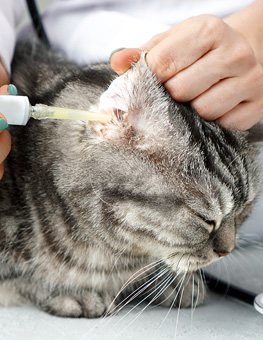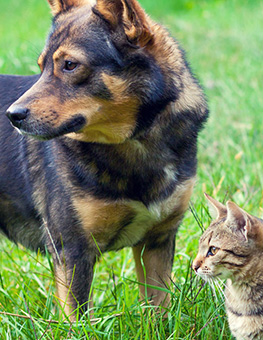Making a Pet First Aid Kit for Cats and Dogs
Having a pet first aid kit will help you be prepared to keep your pet healthy and safe.
While you should take your pet to the veterinarian for any major ailments, it is important to be prepared to handle all facets of health and safety. To do this, you should keep a pet first aid kit handy to respond to emergencies and minor injuries or illnesses. This kit should be stocked with a variety of items that can help you when you don’t want to take a trip to the veterinarian or when you need to help your furry friend right away.
Essential Items
Contact Information: Your first aid kit is a great place to keep emergency contact information for your cat or dog. This should include the number for your veterinarian, for animal poison control (888-4ANI-HELP, there may be a fee for this call), and for an emergency center for your pet. This will be a safe and easy place to keep these numbers and addresses, so that you can address any potential problem quickly and confidently.
Medical Records: If your dog or cat is suffering health problems serious enough to warrant a trip to the emergency clinic or to the veterinarian, it is important to have his records in one place, accessible, and easy to find. Keeping them with your first aid kit is a good way to accomplish this.
Nutritional Supplies: Your pet may suffer from problems that are mainly of a nutritional nature such as dehydration, hypoglycemia or shock. It is thus important to keep some supplies stocked that can address this. These include a high electrolyte, rehydrating solution like Pedialyte® or Gatorade®, and a high source of sugar, like Karo® syrup.
Medical Supplies: You should keep on hand a wide variety of medical equipment to deal with most any health problem that may arise in your dog and cat. Here are some of the things you should keep in your pet first aid kit:
- A current pet first-aid book: It would be a good idea to review this book before you need it
- Rectal thermometer (use with lubricant such as K-Y® jelly): the ideal temperature for cats and dogs is between 100 and 103 degrees Fahrenheit, below or above these temperatures warrants a call to your veterinarian
- Bandage Scissors: for cutting bandages and matted fur
- Tweezers: to remove small foreign items from wounds
- Non-stick bandaging: gauze, pads, bandage rolls, cotton balls
- Antibiotic wipes or ointment
- Splint materials: tongue depressor, 12-inch wooden ruler or thick magazine
- Milk of magnesia and activated charcoal: these absorb ingested poison. Always contact your veterinarian or animal poison control center before treatment
- Mineral oil: a lubricant and laxative when given by mouth
- Kaopectate®: an anti-diarrheal. This should only be used in dogs.
- Styptic pencil or cornstarch: stems blood flow from minor cuts
- Eyewash: check with your veterinarian about which would be best for your pets
- Eyedropper: for flushing wounds or giving oral treatments
- Leather work gloves: to protect you from being bitten
- Muzzle: your pet may want to bite as you attend to his wounds
- Leash (or pet carrier nearby)
- “Instant” ice packs and heating pads
- Disinfectants: soap, anti-septic spray, hydrogen peroxide, antibiotic lotion
- Latex gloves: for your protection
Having a cat or dog first aid kit stocked with these items will ensure that you are prepared for most injuries or ailments you and your pet are faced with. Remember that veterinary care should, if possible, precede, and definitely follow any first aid administered by you.

















